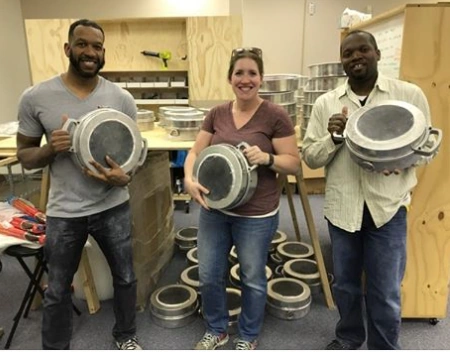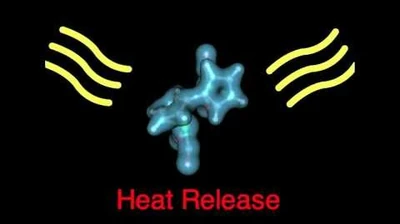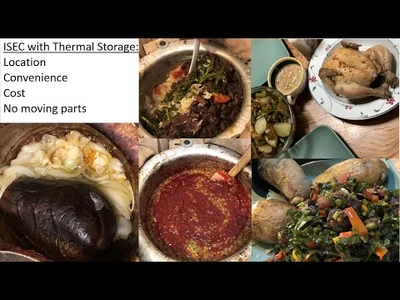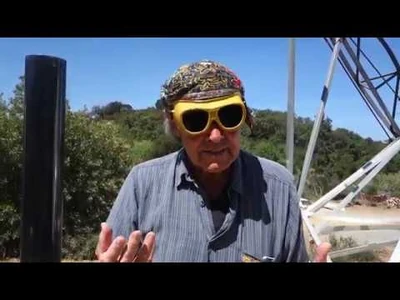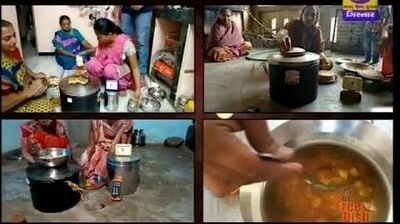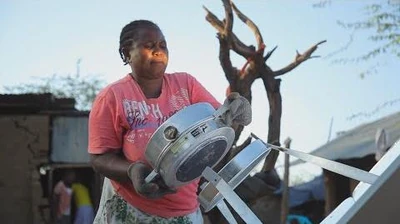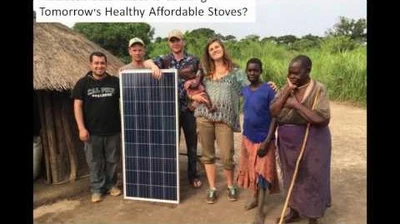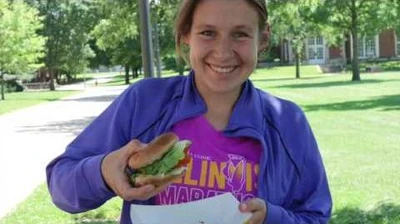Tom Sponheim (talk | contribs) mNo edit summary |
Tom Sponheim (talk | contribs) mNo edit summary |
||
| (67 intermediate revisions by 5 users not shown) | |||
| Line 1: | Line 1: | ||
{{GoogleTranslateLinks}} |
{{GoogleTranslateLinks}} |
||
| − | {{Updated| |
+ | {{Updated|4|1|24}} |
| ⚫ | |||
| − | <table cellspacing="2"><tr> |
||
| ⚫ | ''Heat storage''' for solar cooking typically refers to adding mass to a solar cooker, or other solar reflector array, to store additional heat for cooking after the solar cooker is removed from direct sunlight, thus increasing a solar cooker's efficiency. The most common approaches use either 'sensible' or 'latent' mediums as storage devices. Sensible heat storage incorporates adding a heavy mass, such as black painted bricks or a volume of oil, heated within the cooking chamber prior to cooking. The extra mass gives back its heat, stabilizing cooking temperatures, and extending cooking time into the evening. Alternately, latent heat storage materials are capable of holding more usable cooking heat than sensible materials due to their phase changing nature. A latent heat storage material can either be used with daytime cooking, or heated separately during the day, and then used for cooking after dark or possibly even the next morning. |
||
| − | <td valign="top" width="40%">__TOC__</td> |
||
| − | <td valign="top" width="60%" style="padding:9px;"> |
||
| ⚫ | |||
| − | </td></tr></table> |
||
| ⚫ | Latent heat storage mediums, usually salts, waxes, or high pressure steam, are first heated to a high temperature within a well-insulated container. The medium changes from a solid to a liquid, or liquid to gas, as it is heated, efficiently storing the heat. Cooking can also be done remotely in the kitchen, as the hot medium can be delivered on-demand via piping to the cooking surface, or a self-contained heating module can be brought into the kitchen to use as a stovetop. The [[Media:SCI news 2.pdf|ARUN®100 with Thermal Storage]] at Ramkrishna Mission, Chennai, [[India]] stores heat by sending excess steam to the standby boiler system pressurizing the water supply. Steam used for cooking is later regenerated by flashing the pressurized tank. Materials that undergo a chemical reaction also have the ability to give back stored heat at a later time. |
||
| ⚫ | |||
| − | |||
| ⚫ | Latent heat storage mediums, usually salts, waxes, or high pressure steam, are first heated to a high temperature within a well-insulated container. The medium changes from a solid to a liquid, or liquid to gas, as it is heated, efficiently storing the heat. Cooking can also be done remotely in the kitchen, as the hot medium can be delivered on-demand via piping to the cooking surface, or a self-contained heating module can be brought into the kitchen to use as a stovetop. The [[Media: |
||
[[Heat-retention cooking]] is somewhat similar, and can be used with heat storage devices. It provides layers of insulation around a cook pot to retain the internal cooking temperature initially reached by other means, but does not generate additional heat on its own. |
[[Heat-retention cooking]] is somewhat similar, and can be used with heat storage devices. It provides layers of insulation around a cook pot to retain the internal cooking temperature initially reached by other means, but does not generate additional heat on its own. |
||
| Line 20: | Line 15: | ||
=={{HeadingNews}}== |
=={{HeadingNews}}== |
||
| + | *{{NewJan23}}'''January 2023: Decentralized salt battery heat storage''' - The [https://research.tue.nl/en/organisations/eires Eindhoven University of Technology’s research group (EIRES)], based in the [[Netherlands]], is developing a heat storage technology, which uses a decentralized approach to heat storage and transfer losses. It involves creating a latent heat storage battery with phase-changing salt compounds. At the household level, this may mean a typical refrigerator-sized battery, charged by either photovoltaic, solar thermal, or waste heat sources, will be able to provide a household with several weeks of warm water on one charge. The decentralized approach also minimizes heat transfer losses when compared to a central municipal network. The company [https://cellcius.com/en/ Cellcius], also from the Netherlands, is now developing this battery heat storage system for the manufacture of practical appliances and other relevant use applications. They speak to this lo-tech approach, which employs stable elements, as environmentally friendly and marketable. In January 2023 Cellius won the Breakthrough Energy Explorer Grant, funded by the Gates Foundation to continue their product development. [https://www.ecohubmap.com/the-news/revolutionary-heat-storage-systems/8dwmld6f39b0?fbclid=IwAR1Z_zbOYAiVmrw4Xxg_e7UIwh1PwxIiMybMapjK9RL-J2pIsTjTQ-0TjeE Read more...] |
||
| + | |||
| + | [[File:Komolafe equipment photo, 3-10-22.png|thumb|500px|]] |
||
| + | *{{NewMar22}}'''March 2022: Hybrid solar cooker also provides sensible heat storage for more consistent cooking possibilities''' - A research study conducted by Clement A. Komolafe and Clinton E. Okonkwo from the College of Engineering, Landmark University, Omu Aran, [[Nigeria]], found interesting ways to further the efficiency of solar cooking. The objective was to address majorly health challenge that is predominant among the people living in the rural area who in most cases use firewood and other biomass product for cooking. Locally sourced materials were used to fabricate the cooker. They combined a [[:Category:Solar box cooker designs|solar box cooker]] and a [[:Category:Parabolic solar cooker designs|parabolic solar cooker]] that also incorporated some sensible heat storage with an encouraging outcome. Their research paper can be seen at: [https://www.frontiersin.org/articles/10.3389/fenrg.2022.821098/full Design, Fabrication, and Thermal Evaluation of a Solar Cooking System Integrated With Tracking Device and Sensible Heat Storage Materials] - ''Frontiers in Energy Research''. |
||
| + | |||
[[File:IndianOil_pilot_study,_9-17-19_copy.jpg|thumb|250px|IndianOil director, Dr. SSV Ramakumar, unveiled the start of the indoor solar cooking program in Leh, Ladakh - ''Photo credit; PSU'']] |
[[File:IndianOil_pilot_study,_9-17-19_copy.jpg|thumb|250px|IndianOil director, Dr. SSV Ramakumar, unveiled the start of the indoor solar cooking program in Leh, Ladakh - ''Photo credit; PSU'']] |
||
*{{NewSep19}}'''September 2019: Oil company supports indoor solar cooking:''' - [http://indianoil.in IndianOil] has formed a partnership with the start-up company, [[Sun Buckets]], to sponsor a test pilot program of their indoor solar cooking system in Leh, Ladakh. The Sun Bucket can be ‘charged’ using [[:Category:Parabolic solar cooker designs|parabolic solar concentrators]] kept outdoors. Once charged, the system is capable of storing and discharging the thermal energy on demand for indoor cooking — for boiling, steaming, frying and to make roti. It has enough heat storage capacity to cater to cooking demands during the day as well as at night. [https://www.dailyexcelsior.com/iocl-flags-off-pilot-study-of-solar-indoor-cooking-in-leh/ More information...] |
*{{NewSep19}}'''September 2019: Oil company supports indoor solar cooking:''' - [http://indianoil.in IndianOil] has formed a partnership with the start-up company, [[Sun Buckets]], to sponsor a test pilot program of their indoor solar cooking system in Leh, Ladakh. The Sun Bucket can be ‘charged’ using [[:Category:Parabolic solar cooker designs|parabolic solar concentrators]] kept outdoors. Once charged, the system is capable of storing and discharging the thermal energy on demand for indoor cooking — for boiling, steaming, frying and to make roti. It has enough heat storage capacity to cater to cooking demands during the day as well as at night. [https://www.dailyexcelsior.com/iocl-flags-off-pilot-study-of-solar-indoor-cooking-in-leh/ More information...] |
||
| − | *{{NewAug19}}'''August 2019: Cooking with PV and phase change materials''' - [[Pete Schwartz]] explains how his research group at Cal Poly, [[USA]] is using a relatively low power [[:Category:Photovoltaic cooker designs|photovoltaic panel]] |
+ | *{{NewAug19}}'''August 2019: Cooking with PV and phase change materials''' - [[Pete Schwartz]] explains how his research group at Cal Poly, [[USA]] is using a relatively low power [[:Category:Photovoltaic cooker designs|photovoltaic panel]] directly connected to a resistive heater, which heats a phase change material (PCM, erythritol) for [[heat storage]]. The PCM melts at {{Degree|118}} during exposure throughout the day. In the evening the medium is hot enough to cook a meal fairly quickly without the sun, stored battery power, or further input from the induction heating element. The PCM cooker can be constructed for less than $30, considerably cheaper than a battery storage system. |
| + | |||
::[[File:Cooking with Phase Change Thermal Storage Chicken Stew! Pete Schwartz, Cal Poly Physics|none|400px]] |
::[[File:Cooking with Phase Change Thermal Storage Chicken Stew! Pete Schwartz, Cal Poly Physics|none|400px]] |
||
| − | *{{NewFeb19}}'''January 2019:''' |
+ | *{{NewFeb19}}'''January 2019:''' In 2019, [[Sun Buckets]] in partnership with Acceso Peanut Company, committed to research the causes and extent of post-harvest peanut loss in [[Haiti]]. They wish to design, build, and field test a prototype crop [[dryer]] utilizing solar thermal storage, a product that can also be used for household cooking. Throughout Haiti, the domestic peanut market is characterized by low production volumes and high seasonal price volatility. As such, Haitian peanut farmers will store their peanut harvest for several months until they are able to receive more favorable prices in the market. Often, the crop is exposed to humid conditions without proper ventilation leading to contamination. Through this commitment, Sun Buckets will test the hypothesis that drying practices are the foundational cause of most peanut losses and create a prototype storage container that collects, stores, and recovers solar thermal energy to not only heat air and product, but also move air as needed for a dryer. |
[[File:Tamera,_Portugal_inflatable_reflectors,_3-5-18.png|thumb|300px|Curved inflatable reflectors rotate to focus energy typically on a stationary target. ''Photo credit: Dave Oxford'']] |
[[File:Tamera,_Portugal_inflatable_reflectors,_3-5-18.png|thumb|300px|Curved inflatable reflectors rotate to focus energy typically on a stationary target. ''Photo credit: Dave Oxford'']] |
||
*{{NewMar18}}'''March 2018: Solar powered pizza oven with internal heat storage''' - At Tamera, a community in southern [[Portugal]], there has been experimentation with large inflatable reflectors. Here, you can see six of them mounted on a frame. The whole device is an offset [[tracking|sun-tracking]] parabola. The reflector array rotates, and all of the reflected light falls on a stationary target. In this case, the target is a hole about 10 cm (4 in.) in diameter in the side of a very well insulated box. Inside the box there is room for four slabs of local black granite. These can be heated to over 600°C (1,112°F), but this is too hot for cooking, so instead, the team heats them to 400°C (734°F), and then cooks pizzas on them inside the box (takes about a minute) or they remove the slab and cook directly on it until it cools to around 200°C (367°F), after about half an hour, when it is then returned to the oven. The box is so well insulated, that a slab can be heated on one day, and used to cook breakfast on the next. All this gear is a bit cumbersome for a single household, but it shows that heat storage is possible in practice. The offset parabola was originally designed by Jurgen Kleinwachter, and taken up by Scheffler, who popularised it. Jurgen now works as the team mentor at Tamera. He is seen here demonstrating a set of musical pipes that are powered by sunlight.''' |
*{{NewMar18}}'''March 2018: Solar powered pizza oven with internal heat storage''' - At Tamera, a community in southern [[Portugal]], there has been experimentation with large inflatable reflectors. Here, you can see six of them mounted on a frame. The whole device is an offset [[tracking|sun-tracking]] parabola. The reflector array rotates, and all of the reflected light falls on a stationary target. In this case, the target is a hole about 10 cm (4 in.) in diameter in the side of a very well insulated box. Inside the box there is room for four slabs of local black granite. These can be heated to over 600°C (1,112°F), but this is too hot for cooking, so instead, the team heats them to 400°C (734°F), and then cooks pizzas on them inside the box (takes about a minute) or they remove the slab and cook directly on it until it cools to around 200°C (367°F), after about half an hour, when it is then returned to the oven. The box is so well insulated, that a slab can be heated on one day, and used to cook breakfast on the next. All this gear is a bit cumbersome for a single household, but it shows that heat storage is possible in practice. The offset parabola was originally designed by Jurgen Kleinwachter, and taken up by Scheffler, who popularised it. Jurgen now works as the team mentor at Tamera. He is seen here demonstrating a set of musical pipes that are powered by sunlight.''' |
||
| Line 39: | Line 40: | ||
[[File:Modified_commercial_pot_for_TES_2018.jpg|thumb|Using a modified commercial electric cooker with erythritol as a storage medium]] |
[[File:Modified_commercial_pot_for_TES_2018.jpg|thumb|Using a modified commercial electric cooker with erythritol as a storage medium]] |
||
| − | *{{NewApr16}}'''March 2016:''' [mailto:lecuona@ing.uc3m.es Antonia Lecouna Neumann] reports: "We use [https://en.wikipedia.org/wiki/Erythritol erythritol] as heat storage material, cheap, durable, edible and has a melting heat similar to ice. We found it superior to other alternatives although long term durability is still an issue." [[Media: |
+ | *{{NewApr16}}'''March 2016:''' [mailto:lecuona@ing.uc3m.es Antonia Lecouna Neumann] reports: "We use [https://en.wikipedia.org/wiki/Erythritol erythritol] as heat storage material, cheap, durable, edible and has a melting heat similar to ice. We found it superior to other alternatives although long term durability is still an issue." [[Media:Photovoltaic Solar Cooking with Thermal Energy Storage - CONSOLFOOD 2018 - Lecuona.pdf|Read more...]] |
*{{NewDec15}}'''December 2015: Experimentation with sensible heat storage and lessons learned''' - Mik Hartwell used a recycled satellite disk and a cluster of steel rods for a heat sink, to see if he could cook a meal after the sun had set. The rods got very hot, cooking a meal and holding heat for several hours, but were difficult to work with. [http://www.builditsolar.com/Projects/Cooking/StoredHeat/StoredHeat.htm Read more...] |
*{{NewDec15}}'''December 2015: Experimentation with sensible heat storage and lessons learned''' - Mik Hartwell used a recycled satellite disk and a cluster of steel rods for a heat sink, to see if he could cook a meal after the sun had set. The rods got very hot, cooking a meal and holding heat for several hours, but were difficult to work with. [http://www.builditsolar.com/Projects/Cooking/StoredHeat/StoredHeat.htm Read more...] |
||
*{{NewJul15}}'''July 2015: Advances continue in molecular heat storage possibilities''' - Massachusetts Institute of Technology (MIT) professor, Jeffery Grossman explains how molecular heat storage research is advancing. Solar cooking is a prime candidate for this potentially game changing process to allow cooking early in the morning or in the evening. Specific molecules are able to store heat energy when exposed to sunlight, and release it at a desired time when stimulated by a catalyst. *{{NewJan16}} [http://www.hngn.com/articles/168234/20160111/mit-solar-energy-polymer-material-stores-heat-during-day.htm Update January 2016: MIT researchers feel their discovery might not be suited for solar cooking.] |
*{{NewJul15}}'''July 2015: Advances continue in molecular heat storage possibilities''' - Massachusetts Institute of Technology (MIT) professor, Jeffery Grossman explains how molecular heat storage research is advancing. Solar cooking is a prime candidate for this potentially game changing process to allow cooking early in the morning or in the evening. Specific molecules are able to store heat energy when exposed to sunlight, and release it at a desired time when stimulated by a catalyst. *{{NewJan16}} [http://www.hngn.com/articles/168234/20160111/mit-solar-energy-polymer-material-stores-heat-during-day.htm Update January 2016: MIT researchers feel their discovery might not be suited for solar cooking.] |
||
| + | |||
::[[File:Solar fuel - MIT Professor Jeffrey Grossman|thumb|none|400 px|Massachusetts Institute of Technology (MIT) professor, Jeffery Grossman explains how potential molecular heat storage research is advancing. Solar cooking is a prime candidate for its use.]] |
::[[File:Solar fuel - MIT Professor Jeffrey Grossman|thumb|none|400 px|Massachusetts Institute of Technology (MIT) professor, Jeffery Grossman explains how potential molecular heat storage research is advancing. Solar cooking is a prime candidate for its use.]] |
||
[[File:Morpho_Solar,_IEEE_Spectrum,_10-9-14.png|thumb|300px| [[Guro Seim]], the CEO of [[Morpho Solar]], and [[Catlin Powers]], COO of [[One Earth Designs]], prepare a meal on a [[SolSource]]solar cooker. - ''Morpho Solar'']] |
[[File:Morpho_Solar,_IEEE_Spectrum,_10-9-14.png|thumb|300px| [[Guro Seim]], the CEO of [[Morpho Solar]], and [[Catlin Powers]], COO of [[One Earth Designs]], prepare a meal on a [[SolSource]]solar cooker. - ''Morpho Solar'']] |
||
*'''October 2014: Norwegian start-up tackles heat storage for solar cookers''' - [[Guro Seim]], CEO of Morpho Solar, announced a breakthrough in the heat storage capabilities for solar cookers. They hope to have a production model ready within a year and a half. The breakthrough was recognized with a $8,000 USD award from the Norwegian Ministry of Petroleum and Energy this past August. The company will begin selling the cooker in Europe, and under an agreement with Cambridge, Mass.-based [[One Earth Designs]] in the United States. [http://spectrum.ieee.org/energywise/green-tech/solar/solar-cookers-get-hot Read more...] |
*'''October 2014: Norwegian start-up tackles heat storage for solar cookers''' - [[Guro Seim]], CEO of Morpho Solar, announced a breakthrough in the heat storage capabilities for solar cookers. They hope to have a production model ready within a year and a half. The breakthrough was recognized with a $8,000 USD award from the Norwegian Ministry of Petroleum and Energy this past August. The company will begin selling the cooker in Europe, and under an agreement with Cambridge, Mass.-based [[One Earth Designs]] in the United States. [http://spectrum.ieee.org/energywise/green-tech/solar/solar-cookers-get-hot Read more...] |
||
| − | *'''August |
+ | *'''August 2014: Steam heat storage system used for institutional cooking in India''' - Ram Krishna Mission Student’s Home, Chennai, [[India]] wanted to adopt solar cooking system for its hostel. However the desired cooking times and the availability of sunshine was not matching up. Breakfast is cooked at 4.00 a.m. and lunch cooking starts at 7.00 a.m., while dinner is cooked after 5.00 p.m. A steam-based system, the [[ARUN®100]], with heat storage was designed and commissioned on October 26, 2013. Read more about it at: [[Media:SCI news 2.pdf|ARUN®100 with Thermal Storage at Ramkrishna Mission, Chennai]] - ''[[Ajay Chandak]]'' |
*'''April 2014: A molecular approach to solar heat storage''' Researchers MIT and Harvard University have posted promising results from experiments involving energizing photo-switching molecules, known as azobenzene, to store solar heat gain for extended periods. The molecules are then triggered much later to release their energy for uses requiring heat. Apparently the approach will not be effective for generating electricity, but cooking is a prime candidate. Read more at: [http://news.mit.edu/2014/molecular-approach-to-solar-power A molecular approach to solar power]. |
*'''April 2014: A molecular approach to solar heat storage''' Researchers MIT and Harvard University have posted promising results from experiments involving energizing photo-switching molecules, known as azobenzene, to store solar heat gain for extended periods. The molecules are then triggered much later to release their energy for uses requiring heat. Apparently the approach will not be effective for generating electricity, but cooking is a prime candidate. Read more at: [http://news.mit.edu/2014/molecular-approach-to-solar-power A molecular approach to solar power]. |
||
| Line 73: | Line 75: | ||
===Quicklime heat storage=== |
===Quicklime heat storage=== |
||
| − | The use of quicklime(CaO) for heat storage is not a new concept. Under intense heat, water vapor is released from calcium hydroxide and quicklime is created. Then at a later time, water can be added back to the quicklime, releasing its heat for cooking. It has been proposed that a community [[Scheffler reflector]] would have the capacity to 'charge' CaO units for approximately twenty-five families each day. Families could pick-up their unit of CaO and return to their homes where the CaO would be placed in a special cooker. Cooking heat is controlled by regulating the amount of water added back to the CaO. Benefits of such an approach will allow cooking to happen when the user wishes, inside the home and at night. The materials involved are widely available and nontoxic. Read more: [[Media: |
+ | The use of quicklime(CaO) for heat storage is not a new concept. Under intense heat, water vapor is released from calcium hydroxide and quicklime is created. Then at a later time, water can be added back to the quicklime, releasing its heat for cooking. It has been proposed that a community [[Scheffler reflector]] would have the capacity to 'charge' CaO units for approximately twenty-five families each day. Families could pick-up their unit of CaO and return to their homes where the CaO would be placed in a special cooker. Cooking heat is controlled by regulating the amount of water added back to the CaO. Benefits of such an approach will allow cooking to happen when the user wishes, inside the home and at night. The materials involved are widely available and nontoxic. Read more: [[Media:Development and Testing of a Regenerative Rechargable Solar Stove System.pdf|Development and Testing of a Regenerative Rechargable Solar Stove System]] |
===Self-contained cooking module=== |
===Self-contained cooking module=== |
||
| Line 84: | Line 86: | ||
Sometimes it is desirable to keep fresh foods cool, rather than focusing on gathering and storing heat for cooking purposes. A simple evaporative cooler can provide a solution. The [[Pot-in-pot cooler]] uses two clay pots, one inside the other, separated by a sand barrier. The sand is saturated with water and the cooler is covered with a wet towel. As the water slowly evaporates, heat is taken from the clay pots, keeping perishable food inside cool and fresh for some time. |
Sometimes it is desirable to keep fresh foods cool, rather than focusing on gathering and storing heat for cooking purposes. A simple evaporative cooler can provide a solution. The [[Pot-in-pot cooler]] uses two clay pots, one inside the other, separated by a sand barrier. The sand is saturated with water and the cooler is covered with a wet towel. As the water slowly evaporates, heat is taken from the clay pots, keeping perishable food inside cool and fresh for some time. |
||
| ⚫ | |||
| − | =={{HeadingReports}}== |
||
| ⚫ | |||
| + | ::[[File:S2A3 Ashmore Mawire et al. (South Africa)- Experimental performance of a finned solar cooking st ...-2|none|thumb|400px|Enhancing heat transfer from storage vessel lined with finned walls to the cook pot]] |
||
| + | |||
| ⚫ | |||
| + | ::[[File:S2A2 Ole Jorgen Nydal (Norway)- Heat storage for cooking- a summary ofexperiences with direct sol...-2|none|400px|thumb|An extensive review of latent and sensible methods of [[heat storage]] presented at [[CONSOLFOOD 2023]]]] |
||
| + | |||
| ⚫ | |||
| + | ::[[File:Insulated Solar Electric Cooking with Thermal Storage, EWB Sweden, Pete Schwartz, Cal Poly Physics-2|thumb|400px|none|[[Pete Schwartz]] presents his team's latest findings, as they develop different approaches to insulated solar electric cooking. He predicts an eventual decline in the use of phase change materials (PCMs) to retain the heat for cooking, as batteries will become a more efficient and less expensive way to store energy. This may happen in the next ten years. In the meantime, a solid block of aluminum is showing promise as a simpler way to store heat compared with PCMs.]] |
||
| + | |||
| + | *{{NewApr21}}''' April 2021:''' |
||
| + | ::[[File:Concentrated Solar Mirror, FixFocus, explained by Jürgen Kleinwächter in Tamera-2|none|thumb|400px|Jürgen Kleinwächter explains creating a heat storage and transfer technology for cooking and electricity production with abundant, non-toxic, and inexpensive materials.]] |
||
| + | |||
| ⚫ | |||
| + | ::[[File:Insulated_Solar_Electric_Cooker-_Progress_for_ETHOS_2021,_Pete_Schwartz,_Cal_Poly_Physics|none|thumb|400px]] |
||
| + | |||
| + | *{{NewMay20}}'''May 2020:''' |
||
| + | ::[[File:Solar Electric Cooking in Ghana With Phase Change Thermal Storage, Pete Schwartz, Cal Poly Physics-0|thumb|August, 2019, Pete Schwartz and his team spent 3 weeks in Ghana. They made Solar Electric Cookers with Phase Change Thermal Storage with our newly made friends and colleagues, introducing this cooking method in a small village without electricity. '''Erythritol''', with a melting point of {{Degree|120}}, was used as the heat storage medium. - ''[[Cal Poly Solar Cooking]]''|none|400 px]] |
||
| + | |||
| + | *{{NewMar20}}'''January 2019:''' Presentation from [[CONSOLFOOD 2020]]: |
||
| + | {{FBVideo|https://www.facebook.com/mary.buchenic/videos/vb.100000654375234/2908943642470753}} |
||
| ⚫ | |||
| + | |||
| ⚫ | |||
| + | *{{NewMay19}}'''May 2019:''' |
||
| + | |||
| ⚫ | |||
| + | *{{NewMar18}}'''March 2018:''' |
||
| + | |||
| ⚫ | |||
| + | *{{NewApr20}}'''February 2017:''' |
||
| + | |||
| + | ::[[File:Insulated Solar-Electric Cooking Technology and Uganda, Pete Schwartz, Cal Poly Physics|thumb|none|400 px|See [[Cal Poly Solar Cooking]].]] |
||
| + | *{{NewMar17}}'''January 2017:''' |
||
| + | |||
| ⚫ | |||
| + | *{{NewJul16}}'''June 2016:''' |
||
| + | |||
| ⚫ | |||
| ⚫ | |||
| + | |||
| ⚫ | |||
| + | |||
| + | =={{HeadingDocuments}}== |
||
| + | *{{NewMar23}} '''March 2023:''' [https://www.mdpi.com/1996-1073/16/7/3005 Heat-Transfer Mechanisms in a Solar Cooking Pot with Thermal Energy Storage, Maarten Vanierschot and Ashmore Mawire] - ''energies'' |
||
| + | |||
| + | *{{NewJul22}}'''July 2022:''' [[Media:MECS-Final-Report-Revision5 (Pete Schwartz), July 2022.pdf|MECS Final Report Revisions - ''Dr. Pete Schwartz'']] (Pete provides a summary of his work funded by UK Aid over the last 2.5 years) |
||
| + | |||
| + | *{{NewApr21}}'''April 2021:''' [[Media:Phase change thermal storage - Cooking with more power and versatility - Pete Schwartz.pdf|Phase change thermal storage: Cooking with more power and versatility]] - ''[[Pete Schwartz]], et al'' |
||
| + | |||
| + | *{{NewMay20}}'''January 2020:''' [[Media:Heliac CONSOLFOOD2020 - Final.pdf|SunStore Cooker – A Battery Type Solar Cooker Charged by an Automated Sun Tracking System]] ([[Media:CONSOLFOOD2020 - HELIAC.pdf|Slides]]) - ''Akiko Ishibashi, Jonn Reim, Jakob Jensen'' |
||
| + | |||
| + | *{{NewMay20}}'''January 2020:''' [[Media:HIGH TEMPERATURE SOLAR COOKING SYSTEM.pdf|High Temperature Solar Cooking System With a PCM Energy Storage Unit]] - ''Olivia Alves, V. A. F. Costa'' |
||
| + | |||
| + | *{{NewApr20}}[http://www.consolfood.org/wp-content/uploads/2020/02/S5-6-Di-Nicola-thermal-energy-storage-based-on-xylitol.pdf Experimental testing of a solar box cooker with thermal energy storage based on xylitol] - ''Giovanni Di Nicola, et al'' |
||
| + | |||
*{{NewFeb20}}'''January 2020:''' [[Media:Seggy-Jane-Segaran-Cooking-with-stored-solar-energy-.pdf|Cooking with Stored Solar Energy]] - ''Seggy & Jane Segaran'' |
*{{NewFeb20}}'''January 2020:''' [[Media:Seggy-Jane-Segaran-Cooking-with-stored-solar-energy-.pdf|Cooking with Stored Solar Energy]] - ''Seggy & Jane Segaran'' |
||
| + | |||
*{{NewMay19}}'''February 2019:''' Sagade, A.A., Samdarshi, S.K., Lahkar, P.J., [https://doi.org/10.1016/j.solener.2018.12.069 Ensuring the Completion of Solar Cooking Process under Unexpected Reduction in Solar Irradiance], Solar Energy (Elsevier) 179, 2 February 2019, Pages 286-297. |
*{{NewMay19}}'''February 2019:''' Sagade, A.A., Samdarshi, S.K., Lahkar, P.J., [https://doi.org/10.1016/j.solener.2018.12.069 Ensuring the Completion of Solar Cooking Process under Unexpected Reduction in Solar Irradiance], Solar Energy (Elsevier) 179, 2 February 2019, Pages 286-297. |
||
| ⚫ | |||
| ⚫ | |||
| + | *{{NewApr20}}'''March 2019:''' [https://www.sciencedirect.com/science/article/abs/pii/S0360544218325556 Analysis strategy for multi-criteria optimization: Application to inter-seasonal solar heat storage for residential building needs] - ''S. Launay, B. Kadoch, O. Le Métayer, and C. Parrado'' |
||
| ⚫ | |||
| + | *{{NewApr20}}'''February 2018:''' [https://www.sciencedirect.com/science/article/abs/pii/S0306261917318305 A temperature threshold evaluation for thermocline energy storage in concentrated solar power plants] - ''T. Fasquelle, Q. Falcoz, P. Neveu, and J.-F. Hoffmann'' |
||
| ⚫ | |||
| ⚫ | *{{NewNov17}}'''November 2017:''' [[Media: |
||
| ⚫ | |||
| − | *{{NewMar18}} '''February 2016:''' [http://www.consolfood.org/wp-content/uploads/2015/11/Paper-Antonio-Lecuona.pdf Solar Cooking with Heat Storage: Experiments using PCM and figures of merits for solar cookers] - ''António Lecuona, University of Carlos III-Madrid, [[Spain]]'' |
||
| + | *{{NewMay21}}'''January 2018:'''[[Media:ALONSO-DISSERTATION-2018-compressed.pdf|The development of a portable vessel for the collection, storage, and utilization of solar thermal energy for household use] - ''Matthew Paul Alonso'']] |
||
| ⚫ | |||
| + | |||
| ⚫ | |||
| + | |||
| ⚫ | |||
| + | |||
| ⚫ | |||
| + | |||
| + | *{{NewMay20}}'''January 2017:''' [[Media:20170626 solar cooker UIT.pdf|Experimental characterization of a solar cooker with thermal energy storage based on solar salt]] - ''G Coccia, G Di Nicola, S Tomassetti, G Gabrielli, M Chieruzzi and M Pierantozzi'' |
||
| + | |||
| + | *{{NewApr20}}'''January 2017:''' [[Media:Insulated Solar Electric Cooking - T. Watkins, et al.pdf|Insulated Solar Electric Cooking – Tomorrow's healthy affordable stoves?]] - ''T. Watkins, P. Arroyo, R. Perry, R. Wang, O. Arriaga, M. Fleming, C. O’Day, I. Stone, J. Sekerak, D. Mast, N. Hayes, P. Keller, P. Schwartz - Development Engineering 2 (2017) 47–52.'' [https://www.youtube.com/watch?v=XTQhdjVd0Fk See the associated video]. |
||
| + | |||
| ⚫ | *{{NewNov17}}'''November 2017:''' [[Media:Experimental characterization of a solar cooker with thermal energy storage based on solar salt, Journal of Physics, 11-27-17 .pdf|Experimental characterization of a solar cooker with thermal energy storage based on solar salt]] - ''G. Coccia, G Di Nicola, S Tomassetti, G. Gabrielli, M. Chieruzzi, M. Pierantozzi - Journal of Physics'' |
||
| + | |||
| ⚫ | |||
*{{NewJul18}}'''January 2016:''' [[Media:Antonio-Lecuona-paper-Faro-2016.pdf|Solar Cooking with Heat Storage: Experiments using PCM and figures of merits for solar cookers]] ([[Media:Antonio-Lecuona-presentation-Faro-2016.pdf|Slides]]) - ''António Lecuona'' |
*{{NewJul18}}'''January 2016:''' [[Media:Antonio-Lecuona-paper-Faro-2016.pdf|Solar Cooking with Heat Storage: Experiments using PCM and figures of merits for solar cookers]] ([[Media:Antonio-Lecuona-presentation-Faro-2016.pdf|Slides]]) - ''António Lecuona'' |
||
| − | *{{NewJul15}}'''July 2015:''' [[Media: |
+ | *{{NewJul15}}'''July 2015:''' [[Media:Review of Thermal Storage.pdf|Review on thermal energy storage with phase change materials and applications, October 2007]] - ''Science Direct'' |
*'''September 2014:''' [[Media:SwastikTripathy-2.pdf|Molton Salt Solar Cooker]] - ''Jitendra kumar Dash, Omprakash Parida, Swastik Tripathy and Sagar Dutta, Silicon Institute of Technology, Bhubaneswar, India'' |
*'''September 2014:''' [[Media:SwastikTripathy-2.pdf|Molton Salt Solar Cooker]] - ''Jitendra kumar Dash, Omprakash Parida, Swastik Tripathy and Sagar Dutta, Silicon Institute of Technology, Bhubaneswar, India'' |
||
| − | *'''August 2014:''' [[Media: |
+ | *'''August 2014:''' [[Media:SCI news 2.pdf|ARUN®100 with Thermal Storage at Ramkrishna Mission, Chennai]] - ''[[Ajay Chandak]]'' |
| + | |||
| ⚫ | |||
| ⚫ | |||
| ⚫ | |||
*'''July 2006:''' [[Media:Somesh sharma.pdf|Solar Cooker for Evening / Night Cooking Using Solar Heat Storage Materials]] - ''Someshwer Dutt Sharma'' |
*'''July 2006:''' [[Media:Somesh sharma.pdf|Solar Cooker for Evening / Night Cooking Using Solar Heat Storage Materials]] - ''Someshwer Dutt Sharma'' |
||
| − | *'''July 2006:''' [[Media: |
+ | *'''July 2006:''' [[Media:Granada06 eugenia vieira silva.pdf|Recent Developments of the Solar Cooking System with or without Heat Sotrage for Families and Institutions]] - ''Eugenia Vieira Silva'' |
| + | |||
| + | *{{NewApr20}}'''June 2003:''' [http://www.cuisinesolaire.com/E/Benicarlo03.htm Liquid Tin Heat Storage for Scheffler Parabolic Cookers] - ''[[Michael Götz]]'' |
||
==Articles in the media== |
==Articles in the media== |
||
| + | *{{NewJan23}}'''January 2023:''' [https://www.ecohubmap.com/the-news/revolutionary-heat-storage-systems/8dwmld6f39b0?fbclid=IwAR1Z_zbOYAiVmrw4Xxg_e7UIwh1PwxIiMybMapjK9RL-J2pIsTjTQ-0TjeE Revolutionary heat storage systems] - ''Green Tech'' |
||
| + | *{{NewSep22}}'''September 2022:''' [https://indiaeducationdiary.in/north-west-university-night-time-cooking-with-solar-is-possible-with-thermal-energy-storage/ North-West University: Night-Time Cooking With Solar Is Possible With Thermal Energy Storage] - ''lednewsdesk'' |
||
*{{NewSep19}}'''September 2019:''' [https://www.dailyexcelsior.com/iocl-flags-off-pilot-study-of-solar-indoor-cooking-in-leh/ IOCL flags off pilot study of solar indoor cooking in Leh] - ''Daily Excelsior'' |
*{{NewSep19}}'''September 2019:''' [https://www.dailyexcelsior.com/iocl-flags-off-pilot-study-of-solar-indoor-cooking-in-leh/ IOCL flags off pilot study of solar indoor cooking in Leh] - ''Daily Excelsior'' |
||
*{{NewSep19}}'''September 2019:''' [http://news.statetimes.in/indian-oil-launches-pilot-study-of-indoor-solar-cooking-at-leh/ Indian Oil launches pilot study of indoor solar cooking at Leh] - ''The State Times'' |
*{{NewSep19}}'''September 2019:''' [http://news.statetimes.in/indian-oil-launches-pilot-study-of-indoor-solar-cooking-at-leh/ Indian Oil launches pilot study of indoor solar cooking at Leh] - ''The State Times'' |
||
*{{NewJun19}}'''June 2019:''' [https://www.techexplorist.com/solar-stove-reduces-cooking-costs-80-safer-alternative/23608/?amp&fbclid=IwAR0yzWxiYkjjYImFDb1pgYaaOkwOaohMypo-g-aQcldPsrlsL0c-7Z57VfE Solar Stove reduces the cooking costs by 80% and is a safer alternative] - ''Tech Explorist'' |
*{{NewJun19}}'''June 2019:''' [https://www.techexplorist.com/solar-stove-reduces-cooking-costs-80-safer-alternative/23608/?amp&fbclid=IwAR0yzWxiYkjjYImFDb1pgYaaOkwOaohMypo-g-aQcldPsrlsL0c-7Z57VfE Solar Stove reduces the cooking costs by 80% and is a safer alternative] - ''Tech Explorist'' |
||
*{{NewMar19}}'''March 2019:''' [https://www.centurylife.org/heat-retention-myths-and-facts-does-cast-iron-hold-heat-better-than-clad-is-clad-better-than-disc-base-at-retaining-heat-longer/? - Heat retention myths and facts: Does cast iron hold heat better than clad?] - ''CenturyLife.org'' |
*{{NewMar19}}'''March 2019:''' [https://www.centurylife.org/heat-retention-myths-and-facts-does-cast-iron-hold-heat-better-than-clad-is-clad-better-than-disc-base-at-retaining-heat-longer/? - Heat retention myths and facts: Does cast iron hold heat better than clad?] - ''CenturyLife.org'' |
||
| − | *{{NewFeb18}}'''February 2018:''' [http://saltxtechnology.com/saltx-hackathon-winners-to-solve-climate-change/ SaltX hackathon winners to solve climate change] - ''SaltX Technology'' |
||
*{{NewMay16}}'''May 2016:''' [https://cleantechnica.com/2016/05/13/solar-storage-can-cheaper-coal How Solar + Storage Can Be Cheaper Than Coal] - ''Clean Technica'' |
*{{NewMay16}}'''May 2016:''' [https://cleantechnica.com/2016/05/13/solar-storage-can-cheaper-coal How Solar + Storage Can Be Cheaper Than Coal] - ''Clean Technica'' |
||
*{{NewJan16}}'''January 2016:''' [http://news.mit.edu/2016/store-solar-heat-0107 A new way to store solar heat] - ''MIT News'' |
*{{NewJan16}}'''January 2016:''' [http://news.mit.edu/2016/store-solar-heat-0107 A new way to store solar heat] - ''MIT News'' |
||
| Line 127: | Line 201: | ||
*'''November 2013:''' [https://web.archive.org/web/20190303013649/http://health.universityofcalifornia.edu/2013/11/21/four-global-health-grants-awarded-to-uc-researchers/ Gates Foundation supports development of solar cooker using heat storage] - ''University of California Newsroom'' |
*'''November 2013:''' [https://web.archive.org/web/20190303013649/http://health.universityofcalifornia.edu/2013/11/21/four-global-health-grants-awarded-to-uc-researchers/ Gates Foundation supports development of solar cooker using heat storage] - ''University of California Newsroom'' |
||
*'''February 2012:''' [https://www.engineeringforchange.org/news/2012/02/04/ten_solar_cookers_that_work_at_night.html Ten solar cookers that work at night] - ''Engineering for Change'' |
*'''February 2012:''' [https://www.engineeringforchange.org/news/2012/02/04/ten_solar_cookers_that_work_at_night.html Ten solar cookers that work at night] - ''Engineering for Change'' |
||
| − | *'''June 2008:''' [https://www.renewableenergyworld.com/articles/2008/06/storing-the-sun-molten-salt-provides-highly-efficient-thermal-storage-52873.html#gref Storing the Sun: Molten Salt Provides Highly Efficient Thermal Storage] - ''Renewable Energy World'' |
||
| − | |||
| ⚫ | |||
| ⚫ | |||
| ⚫ | |||
| ⚫ | |||
| ⚫ | |||
| ⚫ | |||
| ⚫ | |||
| ⚫ | |||
| ⚫ | |||
| ⚫ | |||
| ⚫ | |||
| ⚫ | |||
| ⚫ | |||
==See also== |
==See also== |
||
| Line 147: | Line 206: | ||
*[http://solarcooking.wikia.com/wiki/ARUN_100#ARUN_100_with_Thermal_Storage_variation ARUN 100 with Thermal Storage variation, 2014] - ''[[Ajay Chandak]]'' |
*[http://solarcooking.wikia.com/wiki/ARUN_100#ARUN_100_with_Thermal_Storage_variation ARUN 100 with Thermal Storage variation, 2014] - ''[[Ajay Chandak]]'' |
||
*[http://digitalcommons.calpoly.edu/cgi/viewcontent.cgi?article=1023&context=physsp Construction and Improvement of a Scheffler Reflector and Thermal Storage Device, November, 2010] - ''Jason Rapp'' |
*[http://digitalcommons.calpoly.edu/cgi/viewcontent.cgi?article=1023&context=physsp Construction and Improvement of a Scheffler Reflector and Thermal Storage Device, November, 2010] - ''Jason Rapp'' |
||
| − | *[[Media: |
+ | *[[Media:Solar Cookstove Final Report.pdf|Stored Energy Solar Cookstove for Rajasthan, India]]. |
*[[Heat-retention cooking]] |
*[[Heat-retention cooking]] |
||
*[[Sun Buckets]] |
*[[Sun Buckets]] |
||
| Line 155: | Line 214: | ||
*[[Michael Götz]] |
*[[Michael Götz]] |
||
*[[Dieter Seifert]] |
*[[Dieter Seifert]] |
||
| + | *[[Tamera]] |
||
| − | *[[Media: |
+ | *[[Media:Development and Testing of a Regenerative Rechargable Solar Stove System.pdf|Development and Testing of a Regenerative Rechargable Solar Stove System]] - ''Tewodros Eshetu, Shimeles Desalegn, and Dr. A.Venkata Ramayya'' |
| − | == |
+ | ==External links== |
| + | *{{NewApr20}}[http://sharedcurriculum.peteschwartz.net/solar-electric-cooking Solar Electric Cooking] - ''[[Cal Poly Solar Cooking]]'' |
||
*{{NewApr15}}[http://solarcookerdesigns.blogspot.com/p/chemical-types.html Chemical cookers] - ''[[Ashok Kundapur]]'' |
*{{NewApr15}}[http://solarcookerdesigns.blogspot.com/p/chemical-types.html Chemical cookers] - ''[[Ashok Kundapur]]'' |
||
| ⚫ | |||
*[http://blogs.washplus.org/iaqupdates/2013/09/night-cooking-solar-cooker-using-molten-sodium-chloride-as-phase-change-material/ Night Cooking Solar Cooker Using Molten Sodium Chloride as Phase Change Material] - ''O Parida, et al.'' |
*[http://blogs.washplus.org/iaqupdates/2013/09/night-cooking-solar-cooker-using-molten-sodium-chloride-as-phase-change-material/ Night Cooking Solar Cooker Using Molten Sodium Chloride as Phase Change Material] - ''O Parida, et al.'' |
||
*[http://secretsofthesunsects.wordpress.com/2011/11/12/solar-cooker-storage/ Solar Cooker Storage] - ''[[Christopher Jordan]]'' |
*[http://secretsofthesunsects.wordpress.com/2011/11/12/solar-cooker-storage/ Solar Cooker Storage] - ''[[Christopher Jordan]]'' |
||
| Line 165: | Line 225: | ||
*[https://web.archive.org/web/20180903041838/http://www.webplaces.org/solaroven/ The Heat Retention Solar Oven by Ronald L. Conte Jr.] |
*[https://web.archive.org/web/20180903041838/http://www.webplaces.org/solaroven/ The Heat Retention Solar Oven by Ronald L. Conte Jr.] |
||
*[http://www.solarcooking.org/wonderbaskets.htm Heat Retention Cooking vs. Solar Cooking] - ''Mike Bridgwater'' |
*[http://www.solarcooking.org/wonderbaskets.htm Heat Retention Cooking vs. Solar Cooking] - ''Mike Bridgwater'' |
||
| − | *[[Media: |
+ | *[[Media:Development and Testing of a Regenerative Rechargable Solar Stove System.pdf|Development and Testing of a Regenerative Rechargable Solar Stove System]] |
| − | *[[Wolfgang Scheffler]] discussed thermal storage in |
+ | *[[Wolfgang Scheffler]] discussed thermal storage in an interview: "We did some samples. We did a small iron which we used in Portugal in some installations for many years. Because it's small, 50 kilograms of iron is just a few litres, you know, it's like six litres of iron, so it's quite small, so it still cools down a lot. Like when you have 450 degrees in the evening, in the morning you have 300 degrees. If you increase the mass of iron, like what you talked about, like 300, 400 kilograms, then that drop is only 50 degrees overnight. But then the next day you still have a lot of energy to cook and to use. |
*[http://www.cuisinesolaire.com/E/Benicarlo03.htm Liquid Tin Heat Storage for Scheffler Parabolic Cookers] - ''Dr. [[Michael Götz]]'' |
*[http://www.cuisinesolaire.com/E/Benicarlo03.htm Liquid Tin Heat Storage for Scheffler Parabolic Cookers] - ''Dr. [[Michael Götz]]'' |
||
*[http://www.barli.org/solar-storage.html Solar heat storage at Barli Development Institute for Rural Women] |
*[http://www.barli.org/solar-storage.html Solar heat storage at Barli Development Institute for Rural Women] |
||
| + | *{{NewApr24}}'''Patent:''' [https://patents.google.com/patent/US20150159959A1/en Long-Term Heat Storage Device and Method for Long-Term Heat Storage of Solar Energy and Other Types of Energy with Changing Availability] - ''Vladan Petrovic'' |
||
| − | *{{NewJul19}}[http://www.sunrisecsp.com/our-products/sumo-energy-storage/ SUMO Energy Storage] |
||
==Related pages== |
==Related pages== |
||
Latest revision as of 00:04, 2 April 2024
|
Last edited: 1 April 2024
|
|
Sun Buckets heat storage devices ready for shipment to Haiti, May 2017 Photo credit: Sun Buckets
|
Heat storage' for solar cooking typically refers to adding mass to a solar cooker, or other solar reflector array, to store additional heat for cooking after the solar cooker is removed from direct sunlight, thus increasing a solar cooker's efficiency. The most common approaches use either 'sensible' or 'latent' mediums as storage devices. Sensible heat storage incorporates adding a heavy mass, such as black painted bricks or a volume of oil, heated within the cooking chamber prior to cooking. The extra mass gives back its heat, stabilizing cooking temperatures, and extending cooking time into the evening. Alternately, latent heat storage materials are capable of holding more usable cooking heat than sensible materials due to their phase changing nature. A latent heat storage material can either be used with daytime cooking, or heated separately during the day, and then used for cooking after dark or possibly even the next morning.
Latent heat storage mediums, usually salts, waxes, or high pressure steam, are first heated to a high temperature within a well-insulated container. The medium changes from a solid to a liquid, or liquid to gas, as it is heated, efficiently storing the heat. Cooking can also be done remotely in the kitchen, as the hot medium can be delivered on-demand via piping to the cooking surface, or a self-contained heating module can be brought into the kitchen to use as a stovetop. The ARUN®100 with Thermal Storage at Ramkrishna Mission, Chennai, India stores heat by sending excess steam to the standby boiler system pressurizing the water supply. Steam used for cooking is later regenerated by flashing the pressurized tank. Materials that undergo a chemical reaction also have the ability to give back stored heat at a later time.
Heat-retention cooking is somewhat similar, and can be used with heat storage devices. It provides layers of insulation around a cook pot to retain the internal cooking temperature initially reached by other means, but does not generate additional heat on its own.
Benefits[]
- Cooking is possible in the evening.
- Cooking temperatures remain stable if the sun goes behind clouds.
- The solar cooker is already up to temperature when ingredients are added to the pot.
- Cooking is often able to be done inside, in a remote location.
News[]
- January 2023: Decentralized salt battery heat storage - The Eindhoven University of Technology’s research group (EIRES), based in the Netherlands, is developing a heat storage technology, which uses a decentralized approach to heat storage and transfer losses. It involves creating a latent heat storage battery with phase-changing salt compounds. At the household level, this may mean a typical refrigerator-sized battery, charged by either photovoltaic, solar thermal, or waste heat sources, will be able to provide a household with several weeks of warm water on one charge. The decentralized approach also minimizes heat transfer losses when compared to a central municipal network. The company Cellcius, also from the Netherlands, is now developing this battery heat storage system for the manufacture of practical appliances and other relevant use applications. They speak to this lo-tech approach, which employs stable elements, as environmentally friendly and marketable. In January 2023 Cellius won the Breakthrough Energy Explorer Grant, funded by the Gates Foundation to continue their product development. Read more...
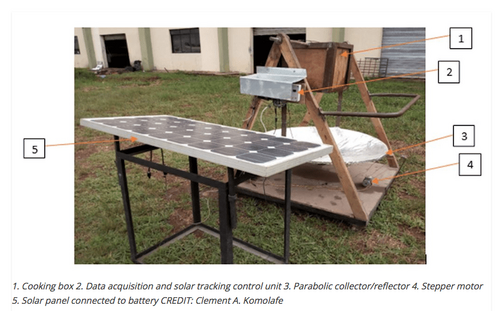
- March 2022: Hybrid solar cooker also provides sensible heat storage for more consistent cooking possibilities - A research study conducted by Clement A. Komolafe and Clinton E. Okonkwo from the College of Engineering, Landmark University, Omu Aran, Nigeria, found interesting ways to further the efficiency of solar cooking. The objective was to address majorly health challenge that is predominant among the people living in the rural area who in most cases use firewood and other biomass product for cooking. Locally sourced materials were used to fabricate the cooker. They combined a solar box cooker and a parabolic solar cooker that also incorporated some sensible heat storage with an encouraging outcome. Their research paper can be seen at: Design, Fabrication, and Thermal Evaluation of a Solar Cooking System Integrated With Tracking Device and Sensible Heat Storage Materials - Frontiers in Energy Research.
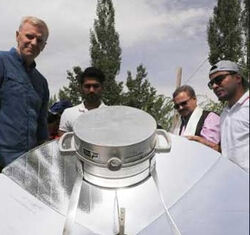
IndianOil director, Dr. SSV Ramakumar, unveiled the start of the indoor solar cooking program in Leh, Ladakh - Photo credit; PSU
- September 2019: Oil company supports indoor solar cooking: - IndianOil has formed a partnership with the start-up company, Sun Buckets, to sponsor a test pilot program of their indoor solar cooking system in Leh, Ladakh. The Sun Bucket can be ‘charged’ using parabolic solar concentrators kept outdoors. Once charged, the system is capable of storing and discharging the thermal energy on demand for indoor cooking — for boiling, steaming, frying and to make roti. It has enough heat storage capacity to cater to cooking demands during the day as well as at night. More information...
- August 2019: Cooking with PV and phase change materials - Pete Schwartz explains how his research group at Cal Poly, USA is using a relatively low power photovoltaic panel directly connected to a resistive heater, which heats a phase change material (PCM, erythritol) for heat storage. The PCM melts at 118 °C (244 °F) during exposure throughout the day. In the evening the medium is hot enough to cook a meal fairly quickly without the sun, stored battery power, or further input from the induction heating element. The PCM cooker can be constructed for less than $30, considerably cheaper than a battery storage system.
- January 2019: In 2019, Sun Buckets in partnership with Acceso Peanut Company, committed to research the causes and extent of post-harvest peanut loss in Haiti. They wish to design, build, and field test a prototype crop dryer utilizing solar thermal storage, a product that can also be used for household cooking. Throughout Haiti, the domestic peanut market is characterized by low production volumes and high seasonal price volatility. As such, Haitian peanut farmers will store their peanut harvest for several months until they are able to receive more favorable prices in the market. Often, the crop is exposed to humid conditions without proper ventilation leading to contamination. Through this commitment, Sun Buckets will test the hypothesis that drying practices are the foundational cause of most peanut losses and create a prototype storage container that collects, stores, and recovers solar thermal energy to not only heat air and product, but also move air as needed for a dryer.
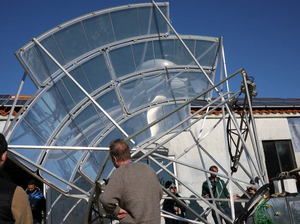
Curved inflatable reflectors rotate to focus energy typically on a stationary target. Photo credit: Dave Oxford
- March 2018: Solar powered pizza oven with internal heat storage - At Tamera, a community in southern Portugal, there has been experimentation with large inflatable reflectors. Here, you can see six of them mounted on a frame. The whole device is an offset sun-tracking parabola. The reflector array rotates, and all of the reflected light falls on a stationary target. In this case, the target is a hole about 10 cm (4 in.) in diameter in the side of a very well insulated box. Inside the box there is room for four slabs of local black granite. These can be heated to over 600°C (1,112°F), but this is too hot for cooking, so instead, the team heats them to 400°C (734°F), and then cooks pizzas on them inside the box (takes about a minute) or they remove the slab and cook directly on it until it cools to around 200°C (367°F), after about half an hour, when it is then returned to the oven. The box is so well insulated, that a slab can be heated on one day, and used to cook breakfast on the next. All this gear is a bit cumbersome for a single household, but it shows that heat storage is possible in practice. The offset parabola was originally designed by Jurgen Kleinwachter, and taken up by Scheffler, who popularised it. Jurgen now works as the team mentor at Tamera. He is seen here demonstrating a set of musical pipes that are powered by sunlight.
- October 2017: Sun Buckets is seeking organizations as early adopters - Experienced organizations are welcome to request an association with Sun Buckets to implement their heat storage devices with their solar cooking programs. More information at: Sun Buckets News
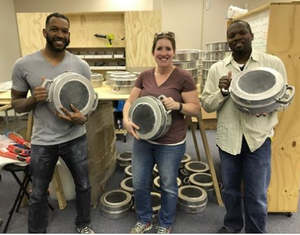
Sun Buckets ready for shipment to Haiti Photo credit: Sun Buckets
- May 2017: Sun Buckets to Haiti: Sun Buckets, a heat retention appliance, has moved into the production mode with units being readied for shipment to southwestern Haiti, with support from Loving Shepard Ministries. However, as of this date, Sun Buckets are not yet available for commercial sales.
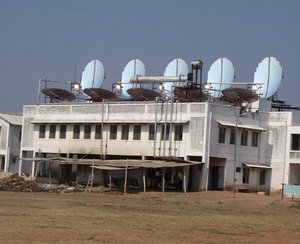
The Muni Seva Ashram, has converted its steam-based Scheffler solar cooking array to use thermic fluid to be able to provide nighttime cooking. - Photo credit: India Herald
- December 2016: Ashram switches from steam to thermic solar cooking - The Muni Seva Ashram, located in Goraj, Vadodara, India, has converted its steam-based Scheffler solar cooking array to use thermic fluid, with heat storage capabilities, to be able to provide nighttime cooking. This is the first such conversion in India, where many existing Scheffler reflector systems are currently in use. The new thermic fluid system also provides the ability to roast, bake, and fry foods, within comfort of the kitchen, not possible with the steam-based system. Read more...
- May 2016: Solar thermal excellence award - Ramakrishna Mission Students’ Home in Chennai was recently conferred with an award for Concentrated Solar Thermal Excellence (CST) for their Solar Cooking System by MNRE, Government of India. The award was given for the school's installation of the ARUN 100 institutional solar steam generating and heat storage system.
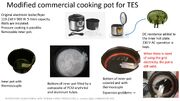
Using a modified commercial electric cooker with erythritol as a storage medium
- March 2016: Antonia Lecouna Neumann reports: "We use erythritol as heat storage material, cheap, durable, edible and has a melting heat similar to ice. We found it superior to other alternatives although long term durability is still an issue." Read more...
- December 2015: Experimentation with sensible heat storage and lessons learned - Mik Hartwell used a recycled satellite disk and a cluster of steel rods for a heat sink, to see if he could cook a meal after the sun had set. The rods got very hot, cooking a meal and holding heat for several hours, but were difficult to work with. Read more...
- July 2015: Advances continue in molecular heat storage possibilities - Massachusetts Institute of Technology (MIT) professor, Jeffery Grossman explains how molecular heat storage research is advancing. Solar cooking is a prime candidate for this potentially game changing process to allow cooking early in the morning or in the evening. Specific molecules are able to store heat energy when exposed to sunlight, and release it at a desired time when stimulated by a catalyst. * Update January 2016: MIT researchers feel their discovery might not be suited for solar cooking.
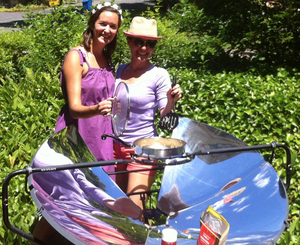
Guro Seim, the CEO of Morpho Solar, and Catlin Powers, COO of One Earth Designs, prepare a meal on a SolSourcesolar cooker. - Morpho Solar
- October 2014: Norwegian start-up tackles heat storage for solar cookers - Guro Seim, CEO of Morpho Solar, announced a breakthrough in the heat storage capabilities for solar cookers. They hope to have a production model ready within a year and a half. The breakthrough was recognized with a $8,000 USD award from the Norwegian Ministry of Petroleum and Energy this past August. The company will begin selling the cooker in Europe, and under an agreement with Cambridge, Mass.-based One Earth Designs in the United States. Read more...
- August 2014: Steam heat storage system used for institutional cooking in India - Ram Krishna Mission Student’s Home, Chennai, India wanted to adopt solar cooking system for its hostel. However the desired cooking times and the availability of sunshine was not matching up. Breakfast is cooked at 4.00 a.m. and lunch cooking starts at 7.00 a.m., while dinner is cooked after 5.00 p.m. A steam-based system, the ARUN®100, with heat storage was designed and commissioned on October 26, 2013. Read more about it at: ARUN®100 with Thermal Storage at Ramkrishna Mission, Chennai - Ajay Chandak
- April 2014: A molecular approach to solar heat storage Researchers MIT and Harvard University have posted promising results from experiments involving energizing photo-switching molecules, known as azobenzene, to store solar heat gain for extended periods. The molecules are then triggered much later to release their energy for uses requiring heat. Apparently the approach will not be effective for generating electricity, but cooking is a prime candidate. Read more at: A molecular approach to solar power.
Types of heat storage[]
- Sensible heat storage: Holding heat in a material without changing its phase when heat is added or removed. Rocks and bricks are examples, which become hot, but remain solid. Oil may also be used, remaining a liquid. More heat is able to be be stored in oil than in other liquids such as water, since water can only be raised to 100 °C (212 °F) without pressurizing it.
- Latent heat storage: Accomplished by using solar heat to melt or gasify a special material, and then when the heat is needed, it is drawn from said material. As it re-solidifies, or re-liquifies, it releases this heat. A large amount of heat can be stored this way, and the temperature during melting or solidification remains constant. The material must melt at a "reasonable" temperature, hot enough to begin and complete the cooking of food, but also low enough to be attainable using solar energy. It must also be reasonably non-toxic, stable, easy to work with, and of course affordable. Salt, Erythritol, and citric acid may be candidates. Another latent heat storage approach is to chemically change a medium, usually under intense heat, and then when it is changed back to it's original form, heat for cooking is released. Research is being done using quicklime (CaO) as this type of medium.
Sensible heat storage examples[]
Solar Rice Cooker[]
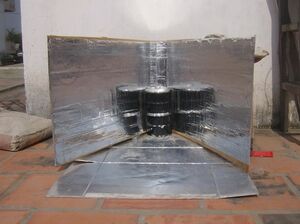
The late Christopher Jordan working in Cambodia, experimented with various styles of solar cookers appropriate for use in locations fairly close to the equator. He became interested in finding ways to extend the available cooking time to early evening. He preferred a simple 'V' shape cooker with fairly tall reflector sides. See: Solar Rice Cooker. The design allows space for dark-colored rocks or bricks to be placed under the cooking pot. Acting like a thermal flywheel, the rocks will soak up heat all day, and give it back in the evening. However, regardless of the style cooker, the rocks need to be insulated to retain their heat, once the sun nears the horizon. He did some experimentation with rock salt as a storage medium, but found it too viscous to be practical. Each locale should each have a viable source of dark-colored rocks, bricks, or sand to use however.
Heat retention solar oven[]
A solar cooker that economically adds both mass and super-insulation as part of the design, is possibly best suited to a solar box cooker approach. This will require a dimensionally larger cooker to fit enough insulation and mass. Also, initial heat-up times will increase to reach working cooking temperatures. The transparent glass panel will need an insulated cover to be placed when solar gain is not available. However, the ovens may be able to reach higher temperatures than are typically achieved, and hold that heat into the evening, and possibly overnight. An oven may take a couple days to reach maximum output. Because of the higher temperature potential, and the prospect that ovens be left out, always on, in all-weather conditions, oven construction materials will need to be non-combustible and weatherproof.
Scheffler heat storage system (sensible)[]
Research is also continuing with incorporating a Scheffler reflector with a heat storage unit. The Scheffler reflector has shown to be an effective way to concentrate heat input to the storage device, with minimal loss of temperature due to not requiring an heat exchanging mechanism. Intense sunlight is focused at an absorption plate attached to an insulated concrete block located inside of the kitchen wall. The block has a system of imbedded metal rods to help evenly distribute the heat within the storage device. It will be important to cover the absorption plate at night, and use insulated covers over the cook plates on top of the storage block when they are not being used for cooking. Early testing has shown cooking in the evening will be possible hours after the sun has set, and potentially early the next morning as well. Read more about the research: Construction and Improvement of a Scheffler Reflector and Thermal Storage Device, November, 2010 - Jason Rapp
Latent heat storage examples[]
Quicklime heat storage[]
The use of quicklime(CaO) for heat storage is not a new concept. Under intense heat, water vapor is released from calcium hydroxide and quicklime is created. Then at a later time, water can be added back to the quicklime, releasing its heat for cooking. It has been proposed that a community Scheffler reflector would have the capacity to 'charge' CaO units for approximately twenty-five families each day. Families could pick-up their unit of CaO and return to their homes where the CaO would be placed in a special cooker. Cooking heat is controlled by regulating the amount of water added back to the CaO. Benefits of such an approach will allow cooking to happen when the user wishes, inside the home and at night. The materials involved are widely available and nontoxic. Read more: Development and Testing of a Regenerative Rechargable Solar Stove System
Self-contained cooking module[]
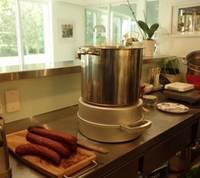
Cooking indoors on a charged Sun Bucket. Photo credit: Sun Buckets
The quest for finding a reasonably compact unit that may easily slip inside a solar box, evacuated tube solar cooker, or pre-charged with a solar panel or parabolic reflector, has been attempted by a number of designers. One company, Sun Buckets, claims to have a working prototype, and hopes to have it available in the marketplace in 2017.
Evaporative cooling[]
- Main article: Pot-in-pot cooler
Sometimes it is desirable to keep fresh foods cool, rather than focusing on gathering and storing heat for cooking purposes. A simple evaporative cooler can provide a solution. The Pot-in-pot cooler uses two clay pots, one inside the other, separated by a sand barrier. The sand is saturated with water and the cooler is covered with a wet towel. As the water slowly evaporates, heat is taken from the clay pots, keeping perishable food inside cool and fresh for some time.
Audio and video[]
- July 2023:
- July 2023:
S2A2 Ole Jorgen Nydal (Norway)- Heat storage for cooking- a summary ofexperiences with direct sol...-2
An extensive review of latent and sensible methods of heat storage presented at CONSOLFOOD 2023
- June 2021:
Insulated Solar Electric Cooking with Thermal Storage, EWB Sweden, Pete Schwartz, Cal Poly Physics-2
Pete Schwartz presents his team's latest findings, as they develop different approaches to insulated solar electric cooking. He predicts an eventual decline in the use of phase change materials (PCMs) to retain the heat for cooking, as batteries will become a more efficient and less expensive way to store energy. This may happen in the next ten years. In the meantime, a solid block of aluminum is showing promise as a simpler way to store heat compared with PCMs.
- April 2021:
- January 2021:
- May 2020:
Solar Electric Cooking in Ghana With Phase Change Thermal Storage, Pete Schwartz, Cal Poly Physics-0
August, 2019, Pete Schwartz and his team spent 3 weeks in Ghana. They made Solar Electric Cookers with Phase Change Thermal Storage with our newly made friends and colleagues, introducing this cooking method in a small village without electricity. Erythritol, with a melting point of 120 °C (248 °F), was used as the heat storage medium. - Cal Poly Solar Cooking
- January 2019: Presentation from CONSOLFOOD 2020:
- August 2019:
Solar Stove™ - UNesar on DD Girnar (Good News Gujarat Show)
Solar Stove™ from UNesar Private Limited featured in Good News Gujarat show on DD Girnar channel. The show was aired on 11th August 2019. Reference DD News Gujarati (https://www.youtube.com/watch?v=By4S7vtdMdM)
- May 2019:
- March 2018:
- February 2017:
- January 2017:
- June 2016:
- July 2014:
Documents[]
- March 2023: Heat-Transfer Mechanisms in a Solar Cooking Pot with Thermal Energy Storage, Maarten Vanierschot and Ashmore Mawire - energies
- July 2022: MECS Final Report Revisions - Dr. Pete Schwartz (Pete provides a summary of his work funded by UK Aid over the last 2.5 years)
- April 2021: Phase change thermal storage: Cooking with more power and versatility - Pete Schwartz, et al
- January 2020: SunStore Cooker – A Battery Type Solar Cooker Charged by an Automated Sun Tracking System (Slides) - Akiko Ishibashi, Jonn Reim, Jakob Jensen
- January 2020: High Temperature Solar Cooking System With a PCM Energy Storage Unit - Olivia Alves, V. A. F. Costa
- Experimental testing of a solar box cooker with thermal energy storage based on xylitol - Giovanni Di Nicola, et al
- January 2020: Cooking with Stored Solar Energy - Seggy & Jane Segaran
- February 2019: Sagade, A.A., Samdarshi, S.K., Lahkar, P.J., Ensuring the Completion of Solar Cooking Process under Unexpected Reduction in Solar Irradiance, Solar Energy (Elsevier) 179, 2 February 2019, Pages 286-297.
- March 2019: Analysis strategy for multi-criteria optimization: Application to inter-seasonal solar heat storage for residential building needs - S. Launay, B. Kadoch, O. Le Métayer, and C. Parrado
- February 2018: A temperature threshold evaluation for thermocline energy storage in concentrated solar power plants - T. Fasquelle, Q. Falcoz, P. Neveu, and J.-F. Hoffmann
- January 2018: Development and prototype testing of MgCl2/graphite foam latent heat thermal energy storage system - Dileep Singh, et al
- January 2018: A Parabolic Solar Cooking System with Heat Storage for Indoor Cooking (Slides, Paper) presented at CONSOLFOOD 2018- Ndiaga Mbodji & Ali Hajji
- January 2018: Hot Stones Cooking with an Ultralight Membrane Solar Concentrator presented at CONSOLFOOD 2018 - Fernando Chacon
- January 2018: Photovoltaic Solar Cooking with Thermal Energy Storage (using erythritol) presented at CONSOLFOOD 2018 - Antonio Lecuona-Neumann, et al
- January 2017: Experimental characterization of a solar cooker with thermal energy storage based on solar salt - G Coccia, G Di Nicola, S Tomassetti, G Gabrielli, M Chieruzzi and M Pierantozzi
- January 2017: Insulated Solar Electric Cooking – Tomorrow's healthy affordable stoves? - T. Watkins, P. Arroyo, R. Perry, R. Wang, O. Arriaga, M. Fleming, C. O’Day, I. Stone, J. Sekerak, D. Mast, N. Hayes, P. Keller, P. Schwartz - Development Engineering 2 (2017) 47–52. See the associated video.
- November 2017: Experimental characterization of a solar cooker with thermal energy storage based on solar salt - G. Coccia, G Di Nicola, S Tomassetti, G. Gabrielli, M. Chieruzzi, M. Pierantozzi - Journal of Physics
- February 2016: Portable Stored Solar Thermal Energy for Household Use - University of Illinois at Urbana-Champaign and Sun Buckets, Inc.
- January 2016: Solar Cooking with Heat Storage: Experiments using PCM and figures of merits for solar cookers (Slides) - António Lecuona
- July 2015: Review on thermal energy storage with phase change materials and applications, October 2007 - Science Direct
- September 2014: Molton Salt Solar Cooker - Jitendra kumar Dash, Omprakash Parida, Swastik Tripathy and Sagar Dutta, Silicon Institute of Technology, Bhubaneswar, India
- September 2013: Development and Optimization of a Thermal-Storage Solar Cooker - David Gordon Wilson
- November 2010: Construction and Improvement of a Scheffler Reflector and Thermal Storage Device, 2010
- July 2006: Solar Cooker for Evening / Night Cooking Using Solar Heat Storage Materials - Someshwer Dutt Sharma
- July 2006: Recent Developments of the Solar Cooking System with or without Heat Sotrage for Families and Institutions - Eugenia Vieira Silva
Articles in the media[]
- January 2023: Revolutionary heat storage systems - Green Tech
- September 2022: North-West University: Night-Time Cooking With Solar Is Possible With Thermal Energy Storage - lednewsdesk
- September 2019: IOCL flags off pilot study of solar indoor cooking in Leh - Daily Excelsior
- September 2019: Indian Oil launches pilot study of indoor solar cooking at Leh - The State Times
- June 2019: Solar Stove reduces the cooking costs by 80% and is a safer alternative - Tech Explorist
- March 2019: - Heat retention myths and facts: Does cast iron hold heat better than clad? - CenturyLife.org
- May 2016: How Solar + Storage Can Be Cheaper Than Coal - Clean Technica
- January 2016: A new way to store solar heat - MIT News
- December 2015: This solar cooker will work at night too - The Times of India
- December 15, 2015 IISc scientists develop solar cooking device - Deccan Herald (New Delhi)
- April 2014: A molecular approach to solar power - MIT News
- December 2013: Solar-Powered - New University
Gates Foundation UCI recipients explain their goals for improving their heat storage solar cooking system. - November 2013: Gates Foundation supports development of solar cooker using heat storage - University of California Newsroom
- February 2012: Ten solar cookers that work at night - Engineering for Change
See also[]
- UNesar Private Limited
- ARUN 100 with Thermal Storage variation, 2014 - Ajay Chandak
- Construction and Improvement of a Scheffler Reflector and Thermal Storage Device, November, 2010 - Jason Rapp
- Stored Energy Solar Cookstove for Rajasthan, India.
- Heat-retention cooking
- Sun Buckets
- Solar Rice Cooker
- Solar Cooker for Evening / Night Cooking Using Solar Heat Storage Materials, July, 2006 - Someshwer Dutt Sharma
- Wolfgang Scheffler
- Michael Götz
- Dieter Seifert
- Tamera
- Development and Testing of a Regenerative Rechargable Solar Stove System - Tewodros Eshetu, Shimeles Desalegn, and Dr. A.Venkata Ramayya
External links[]
- Solar Electric Cooking - Cal Poly Solar Cooking
- Chemical cookers - Ashok Kundapur
- Night Cooking Solar Cooker Using Molten Sodium Chloride as Phase Change Material - O Parida, et al.
- Solar Cooker Storage - Christopher Jordan
- Molten Salt Solar Cooker, Silicon Institute of Technology, Bhubaneswar, India
- The Heat Retention Solar Oven by Ronald L. Conte Jr.
- Heat Retention Cooking vs. Solar Cooking - Mike Bridgwater
- Development and Testing of a Regenerative Rechargable Solar Stove System
- Wolfgang Scheffler discussed thermal storage in an interview: "We did some samples. We did a small iron which we used in Portugal in some installations for many years. Because it's small, 50 kilograms of iron is just a few litres, you know, it's like six litres of iron, so it's quite small, so it still cools down a lot. Like when you have 450 degrees in the evening, in the morning you have 300 degrees. If you increase the mass of iron, like what you talked about, like 300, 400 kilograms, then that drop is only 50 degrees overnight. But then the next day you still have a lot of energy to cook and to use.
- Liquid Tin Heat Storage for Scheffler Parabolic Cookers - Dr. Michael Götz
- Solar heat storage at Barli Development Institute for Rural Women
- NEW: Patent: Long-Term Heat Storage Device and Method for Long-Term Heat Storage of Solar Energy and Other Types of Energy with Changing Availability - Vladan Petrovic

